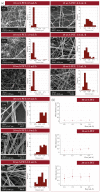Submicronic Filtering Media Based on Electrospun Recycled PET Nanofibers: Development, Characterization, and Method to Manufacture Surgical Masks
- PMID: 35335738
- PMCID: PMC8952864
- DOI: 10.3390/nano12060925
Submicronic Filtering Media Based on Electrospun Recycled PET Nanofibers: Development, Characterization, and Method to Manufacture Surgical Masks
Abstract
The disposal of single-use personal protective equipment has brought a notable environmental impact in the context of the COVID-19 pandemic. During these last two years, part of the global research efforts has been focused on preventing contagion using nanotechnology. This work explores the production of filter materials with electrohydrodynamic techniques using recycled polyethylene terephthalate (PET). PET was chosen because it is one of the materials most commonly present in everyday waste (such as in food packaging, bags, or bottles), being the most frequently used thermoplastic polymer in the world. The influence of the electrospinning parameters on the filtering capacity of the resulting fabric was analyzed against both aerosolized submicron particles and microparticulated matter. Finally, we present a new scalable and straightforward method for manufacturing surgical masks by electrospinning and we validate their performance by simulating the standard conditions to which they are subjected to during use. The masks were successfully reprocessed to ensure that the proposed method is able to reduce the environmental impact of disposable face masks.
Keywords: COVID-19; PET; aerosol; electrospinning; face mask; fibers; filtration; nanotechnology.
Conflict of interest statement
The authors declare no conflict of interest.
Figures













References
-
- Graulich K., Köhler A., Low C., Sutter J., Watson D., Mehlhart G., Egebae K.K., Bilsen V., Bley F. Impact of COVID-19 on Single-Use Plastics and the Environment in Europe. Volume 10. European Environment Agency; Boeretang, Belgium: 2021. [(accessed on 17 February 2022)]. pp. 142–149. Available online: http://europa.eu.
-
- Chattopadhyay S., Hatton T.A., Rutledge G.C. Aerosol filtration using electrospun cellulose acetate fibers. J. Mat. Sci. 2015;51:204–217. doi: 10.1007/s10853-015-9286-4. - DOI
LinkOut - more resources
Full Text Sources

